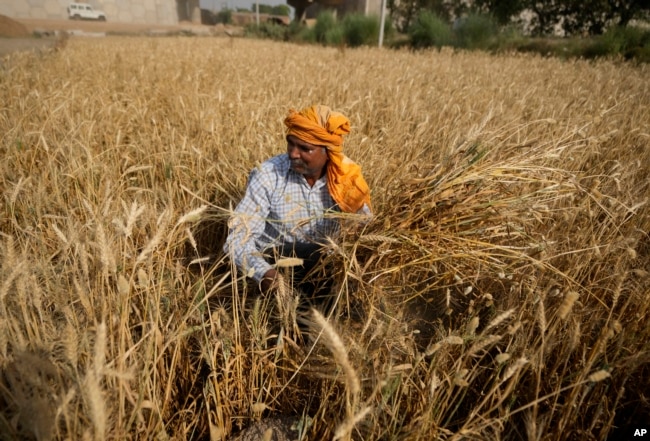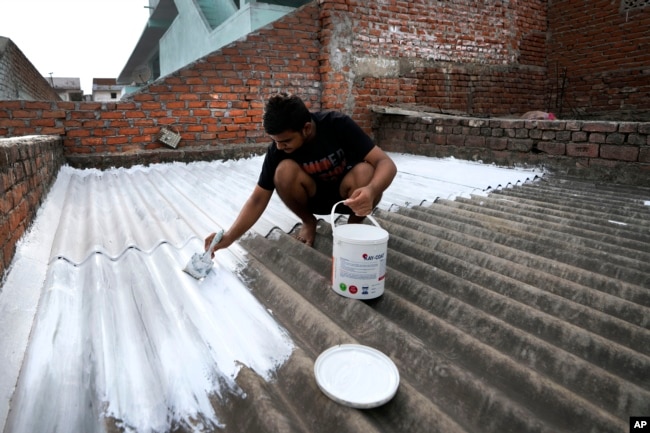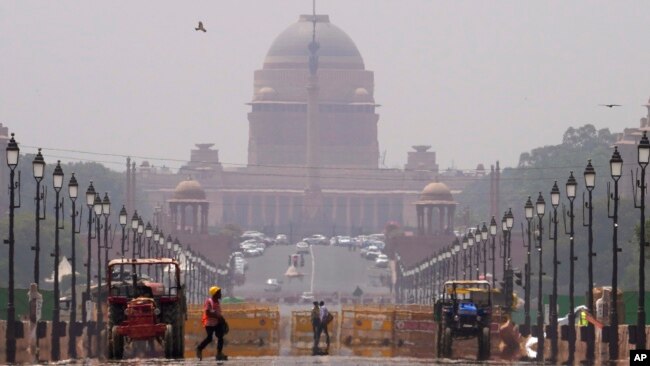”暑さに目覚めよ!!”そして、備えよ!!
”Wake up heat!!”
この言葉、スローガンになりますね!!
窓にはUV削減、熱遮断効果のあるフィルムを貼って、これからの夏に備えています。45度、50度には耐えられません。
VOAで英語を学びましょう!!
報告:南アジアの熱波は気候変動により30倍に増加(和訳)
Report: South Asia’s Heat Waves 30 Times Likelier with Climate Change
May 28,2022
国際的な科学者の報告によると、最近インドとパキスタンで起こった悲惨な猛暑は、気候変動によってより起こりやすくなったとのことです。
また、このような天候がより一般的になる可能性が高いとしています。
World Weather Attributionは、英国、フランス、インド、オランダ、スイス、米国、赤十字社の気象科学者のグループで、5月23日に報告書を発表しました。
報告書によれば、地球上の広い範囲に影響を及ぼす熱波は稀であり ---100年に一度の割合で発生しています。しかし、気候変動はこの30倍の可能性があるとしています。
インド工科大学(ムンバイ)の気候研究者であるアルピタ・モンダル氏によれば、もし大気の平均温度が工業化以前のレベルより2度上昇すれば、大きな熱波は100年に2回、あるいはそれ以上起こる可能性があるとのことです。彼女は、5年に一度の熱波もあり得ると言います。
「これは来るべき事態の兆候です。」と同科学者は語ります。
保守的な結果
この結果は、他と比較して保守的です。先週、英国の気象庁は、今回の熱波は気候変動によって100倍以上起こりやすくなったと考えられると発表しました。
ロンドン大学インペリアルカレッジのフリーデリケ・オットー氏も、世界気象帰属報告書の作成に携わりました。
「気候変動がこの現象をどれだけ増加させたかについて、実際の結果はおそらく我々と(英国)気象庁の結果の間のどこかにあります。」と、同気候科学者は言います。
この熱波は、大きい被害はもたらしています。インドの都市とパキスタンでは、この数週間で45℃を超える気温が報告されました。パキスタンでは、ジャコババードやダドゥなど一部の場所で50℃を超える気温が報告され、インドの首都ニューデリーの一部では、今月49度の気温が報告されました。
インドでは、このような記録保持が始まった1901年以来、最も暑い3月を記録しました。パキスタンとインドの一部では、4月が記録的な暑さでした。
その影響は広範囲に及んでいます。パキスタンでは氷河が決壊し、洪水が発生しました。また、インドでは暑さのために小麦が被害を受けました。このため、ロシアのウクライナ戦争で食糧不足に陥っている国々への輸出を停止せざるを得なくなったのです。また、この猛暑により、例年より早い電力需要が発生しました。石炭の供給が減り、電力不足で何百万人もの人々が影響を受けました。
どうしたらいいのか?
人体への影響も甚大でした。両国では少なくとも90人が死亡しています。科学者たちは、死者が必ずしも公式に記録されていないため、この数字はもっと多いと指摘します。
AP通信(Associated Press)は、コロンビア大学の気候学スクールの情報を調査しました。それによると、熱ストレスの影響を最も受けているのは南アジアであることがわかりました。インドには、世界人口の3分の1以上住んでおり、彼らは気温が上昇している地域に住んでいます。
熱ストレスの危険性が最も高いのは、子供と老人です。また、暑さは、エアコンのような冷却装置を持たない貧しい人々にも厳しいものです。多くの貧困層は、大都市の混雑した汚い地域に住んでいます。
ラーマン・アリさんはニューデリーで42歳の屑拾いをしています。屑拾いする人は、人々の家からゴミを取り出し、その中から価値のあるものを探し出して売ります。この仕事は体にとても負担がかかり、アリさんの収入は1日3ドルにもなりません。
「どうしたらいいんだろう?働かなければ食べていけないんだ。」とこの2児の父は言います。
インドのいくつかの都市が、答えを見つけようとしています。西部のアーメダバード市は2013年、南アジアで初めて、人口840万人超の熱波対策計画を策定しました。この計画には、医療従事者や住民に熱波に備えるよう伝える早期警報システムが含まれています。また、行政は、人々が日差しを避けられるように公園を開放しておくことを許可しています。また、学校に情報を提供し、授業時間を変更させることもできます。
インド西部の都市ガンディナガルにあるインド公衆衛生研究所を率いるディリープ・マヴァランカル博士。2013年の計画策定に協力しました。また、同市では、家の上部を冷やすのに役立ちそうな素材の実験も行っていると彼は言います。太陽の熱をためない屋根を作ることが目的です。白いペンキや乾燥した草のような低コストの材料を使って、家を熱から守っている人もいます。
インドのほとんどの都市は、準備が整っていません。インドの連邦政府は現在、23州130都市と協力して同様の計画を策定しています。
今月初めには、連邦政府は各州に対して、暑さによる病気の治療について医療従事者を訓練するよう要請しました。また、氷や薬品による治療、冷却装置を病院内で利用できるようにすることも求めました。
公衆衛生専門家のマヴァランカー氏は、このグループ研究には参加していなせん。しかし、彼はインドのほとんどの都市で、猛暑に関する公式な警告がないことを指摘します。彼は、地方政府が、彼の言葉を借りれば、"暑さに目覚めていない "だけだと言っています。
Report: South Asia’s Heat Waves 30 Times Likelier with Climate Change
International scientists report that the disastrous severe heat wave in India and Pakistan recently was made more likely by climate change.
They also say that such weather is likely to become more common.
World Weather Attribution is a group of weather scientists from Britain, France, India, the Netherlands, Switzerland, the United States, and the Red Cross. It released its report May 23.
The report says heat waves that affect a large area of Earth are rare --- happening once every 100 years. But it said climate change now makes big heat waves 30 times more likely.
The scientists said if the atmosphere’s average temperature increases to 2 degrees Celsius more than pre-industrial levels, big heat waves could happen twice every hundred years or more, says Arpita Mondal, a climate researcher at the Indian Institute of Technology in Mumbai. She suggests heat waves as often as every five years are possible.
“This is a sign of things to come,” the scientist said.
Conservative results
The results are conservative in comparison to others. Last week, Britain’s Meteorological Office said the heat wave was probably made 100 times more likely by climate change.
Friederike Otto of the Imperial College of London also worked on the World Weather Attribution report.
“The real result is probably somewhere between ours and the (U.K.) Met Office result for how much climate change increased this event,” the climate scientist said.
The heat wave has been very damaging. Indian cities and Pakistan reported temperatures above 45 degrees Celsius in the past weeks. Pakistan reported temperatures over 50 degrees Celsius in some places like Jacobabad and Dadu. Parts of India’s capital New Delhi reported temperatures of 49 degrees this month.
India recorded the hottest March in the country since 1901, when such record-keeping began. April was the warmest on record in Pakistan and parts of India.
The effects have been widespread. A glacier burst in Pakistan, causing floods. The heat also damaged wheat crops in India. The problem forced the government to stop exports to nations facing food shortages linked to Russia’s war in Ukraine. The heat wave also resulted in earlier than usual demand for electricity. The coal supply shrank leading to power shortages affecting millions of people.
‘What can we do?’
The effects on human health were also damaging. At least 90 people have died in the two countries. Scientists suggest the number is higher because deaths are not always officially recorded.
The Associated Press (AP) studied information from Columbia University’s climate school. It found that South Asia is the most affected by heat stress. India is home to more than one third of the world’s population that lives where temperatures are increasing.
Children and old people are most at risk from heat stress. Heat is also harder on the poor who do not have cooling systems, like air conditioners. Many poor people live in crowded, dirty neighborhoods in large cities.
Rahman Ali is a 42-year-old ragpicker in New Delhi. Ragpickers remove trash from people’s homes and search through it for anything of value to sell. The job is very hard on his body and earns Ali less than three dollars a day.
“What can we do? If I don’t work…we won’t eat,” said the father of two.
Some Indian cities have tried to find answers. The western city of Ahmedabad was the first in South Asia to design a heat wave plan for its population of over 8.4 million in 2013. The plan includes an early warning system that tells health workers and residents to prepare for heat waves. It permits administrations to keep parks open so that people can keep out of the sun. And it provides information to schools so they change class hours.
Dr. Dileep Mavalankar heads the Indian Institute of Public Health in the western Indian city of Gandhinagar. He helped design the 2013 plan. He said the city has also been experimenting with materials that may help cool the tops of houses. The aim is to build roofs that do not hold the sun’s heat. Some people use white paint or low-cost materials like dried grass to protect their homes from the heat.
Most Indian cities are less prepared. India’s federal government is now working with 130 cities in 23 states to develop similar plans.
Earlier this month, the federal government also asked states to train health workers in treating heat-related illnesses. It also asked that ice, chemical treatments, and cooling devices be available in hospitals.
Public health expert Mavalankar was not part of the group study. But he pointed to a lack of official warnings about extreme heat in most Indian cities. He said the local governments have just not, in his words, “woken up to the heat.”
Words in This Story
glacier –n. a large area of ice that moves slowly down a valley
stress –n. a state of tension caused by worry or difficult conditions
resident –n. a person who lives in a particular place


